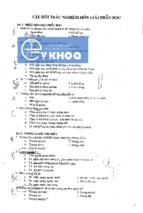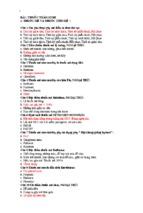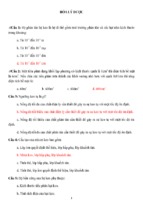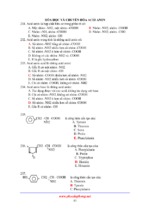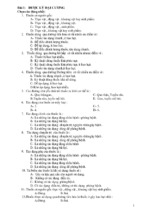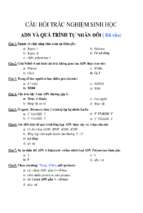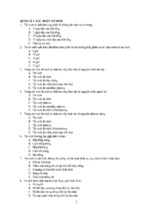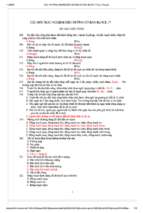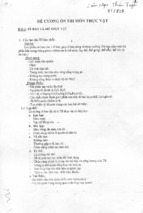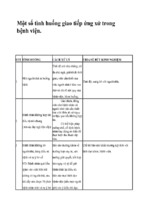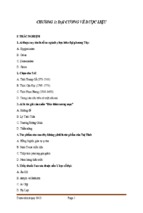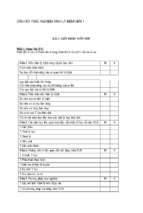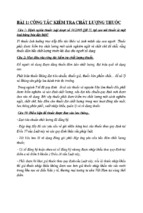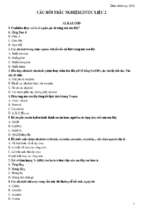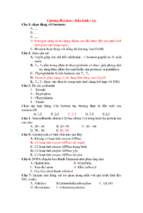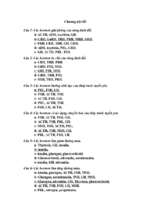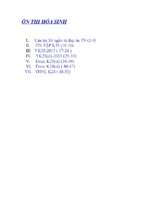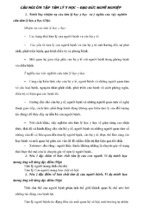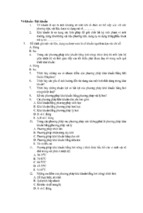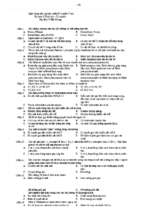Mô tả:
Trạm 1
1.The onset of menses is known as………………
a. menarche
b menopause
c. menstruation d monthly
period
2. Be sure he’s NPQ(nil per os). You must not give him
anything……………
a. by injection b. into his muscles by mouth d. into his vein
3. The human body is made…………. Millions of cells
a. of
b. from
c. up
d. up of
4. It is very difficult for him to walk because his…………………. is
sore.
a. nose b.heel
c. abdomen
d. throat
5.I have to go to the dentist because I have a ……………. Tooth
a. decelved
b.declared c.diseased d.decayed
6.People with hepertension may ……………. Headaches
a. complain
b. complain about c. complain of
d complain
of
7.An elderly person is more…………….. to fractures than a youger
person.
a. likely to die b. likely to recover c. likely to heal
d. likely to be
affected
8.The boxlike space at the top windpipe, containing the vocal cords
which produce voice, is called the…………………..
a. throat larynx
c.ligament
d. disc
9. The diaphragm…………..
a. is the upper part of the body
b. is also called abdomen
c. is separated by a partition
d. separates the chest from abdomen
10.the terminal point of the digestive system is the……………………
a. lips
b. mouth
c stomach d. anus
11. A kidney stone is a……………….condition
a. genital
b respiratory
c. urinary d. digestive
12. The…………… is the place where urine accumulates, pending
micturition
a. kidney
b. bladder c ureter
d urethra
13. Fertilization begins in the..............................
a. ovary
b. uterine tube
c. Uterus
d. Vagina
14. Gonads are also called.............glands
a. endocrine
b. exocrine c. sex
d. female
15. The unabsorbed substances are excreted as
a. mucus
b. aliments c. secrections
d. stools.
16. The main parts of the respiratory system are the airways and
the……………
a. heart
b.lobes
c lungs
d larynx
17. Do you have any pain when you pass water? Is the question
referring to the following symptom.
a. dysuria
b. dysphagia
c. diplopia d.dyspnoea
18. I’ve been feeling off – colour for two days. The underlined words
mean:
a. unwell
b well
c. healthy d exhausted
19. Cranial arteritis may …………… as fever without any obvious
causes.
a. presentation b. presenting
c present
d.presents
20. Pernicious……………..is a very dangerous disease.
a. diagnosis
b. deficiency
c anaemia d. marrow
21. White blood cells are also named…………….
a. erythrocytes b. thrombocytes c. leucocytesd All correct
22. Normal stools are brown in colour, and semi-solid, or
a. formed.
b. hard
c loose
d.
liquid
23. The term period pains means……………….
a. menorrhagia b. menarch
c discharge d dysmenorrhoea
24. Four stages in normal medical examination are:
inspection,...................percussion and auscultation.
a. palpitation b. palpation
c cyanosis d. rhythm
25…………….. is a sudden loss of consciousness due to temporary
failure of the cerebral circulation
a. sensation
b. tremor
c. syncope d. paralysis
26. The adjective of the word “ flaccidity”
a. flaccid
b. flaccidy
c. flaccidness
d. flaccidly
27. Motion………… is a popular healthy problem for people who
often travel.
a. disease
b. sickness
c. illness
d. problem
28 the time when a woman stops menstruating is called……………
a.. climacteric b. menorrhagia
c. menarche d. contraception
29. ……………….. indicate the narrowing of the airways
a. Crackles
b. Wheezes
c. Pleural rubs
d. breath
sounds
30. The bridge is full of foods, but my sense of …………. Had
disappeared and I can’t enjoy their flavour
a. taste
b. touch
c. numbness
d. appetite
31. The body excluding the head and limbs is called he
a. breast
. thigh
c trunk
d navel
32. …………. Wound is the one caused by a knife
a. incised
b penetrating
c abrasion d laceration
33. When the patient returns to normal health after an illness, she/he
has……………
a. recovered
b improved
c deteriorated
d. relapsed
34. The urine is carried to the bladder by the……………….
a. pelvis
b.kineys
c. Urethra d. Ureters
35. ........... the fracture means replacing the fragments in their
antomical position
a. reducing
b. jointing
c healing
d displaying
36. The anaemia may be due to …………… breakdown
a. erythocyte b. leukocyte
d thrombocyte
d. platelet
37 The goitre involving most of the thyroid gland is a………… one
a. bruit
b. thrill
d. localized
d.diffuse
38. In an examination of the abdomen…………… may be due to pain
or anxiety and can be reduced if the patient is persuaded to relax.
a. tenderness b. guarding
c. rigidity
d. rebound
tenderness
39. When the patient is aware of irregularity of his/her heart rhythm,
he/she describes the symptoms………………………
a. fibrillation b. premature beatsc heart failure
d
palpitations
40. The term for the symptom of pins and needles is
a. tinitus
b.diplopia
c. paraesthesiae d. anesthesia
41. A tic is a form of …………… movement
a. voluntary
b. voluntarily
c. involuntary
d.
involuntarily
42. A patient who has a loose cough produces phlegm. The
underlined word means:
a. crackle
b.sputum
c. sound
d. all are wrong
43. A contusion is a form of mechanical injures caused by………
a. sharp force b. blunt forec
c. knife
d.
razor blade
44. …………. Is the anlysis of urine
a. frequency b. dysuria
c. urinary incontience d. urinalysis
45. When you say you have got a………………. it means that you have
an abdominal pain
a. stomachache b. headache
c. toothache
d. all correct
46. Elbow is a part of the…….
a. trunk
b. lower limb
c upper limb
d.
head
47 The ………….. seperates the chest from the abdomen
a. windpipe
b. lung
c. diaphragm
d.
bladder
48. ………… are what the doctor finds on examining the patient
a. symptoms b.signs
c.complaints
d. all
wrong
49. Blindness may be caused by vitamin A……………
a. breakdown b. destruction
c. production
d.
deficiency
II Fill the blank with the vocabulary listed below:
Abdomen
eyelid
ribs
Toes
nipples
throat
1. There are ten tingers on the hands and ten…………. On the feet
2. The small and large intestines are found in the ………….
3. It is difficult for him to swallow because his ……………. is sore
4. The …………. Covers and protects the eyes.
5. Surrounding and protecting our lungs are twelve pairs
of…………….
6. The…………….. are located on the mammary gland. Milk is drawn
through them during breast feeding
III Translate into Vietnamese
1. The brain is the primary center for regulating and coordinatin body
activities.In the human adult it weighs about 3 pounds and has
many different parts, all of which control different aspects of body
functions. The largest part of the brain is the cerebrum. It has many
functions. All thought, judgment, memory, association, and
dscrimination take place within it.
…………………………………………………………………………………
…………………………………………………………………………………
…………………………………………………………………………………
…………………………………………………………………………………
…………………………………………………………………………………
…………………………………………………………………………………
…………………………………………………………………………………
………………………………………………………..
2. Food passes from the esophagus into the stomach. The stomach is
composed of an upper portion called the fundus a , middle section
known as the body, and a lower portion the polyrus. Rings of
muscles called spincters control the opening into and from the
stomach.
…………………………………………………………………………………
…………………………………………………………………………………
…………………………………………………………………………………
…………………………………………………………………………………
…………………………………………………………………………………
…………………………………………………………………………………
………………………………………………
3. The four limbs, which are often called the four extremities; they are,
of course, two arms and two legs. The arms are also referred to as
the upper limbs or upper extremities and the legs as the lower limbs
or lower extremities.
…………………………………………………………………………………
…………………………………………………………………………………
…………………………………………………………………………………
…………………………………………………………………………………
…………………………………………………………………………………
……………………………………......
Organs and systems
The body consists very largely of structures known as organs. We have
all heard of such structrures as the brain, the heart, the lungs, the liver,
the stomach, the kidneys, and the bladder – these are all examples of
organs. Another name for an organ is a viscus (plural, viscera), and we
often speak of all the organs inside the abdomen as the abdominal
viscera and of the organs inside the thorax as the thoracic viscera
For the most part, the organs of the body are grouped into systems,
and a system consists of a group of organs which cooperate in carrying
out particular functions. The muscular system, for example, consists of
a large number of units called muscles, which together make up the
flesh of the body; and the blood vascular system consists of the heart
which pumps the blood, together with a series of tubes called blood
vessels, which carry the blood to all parts of the body and back again to
the heart . The following systems may be recognized; the osseous,
muscular, nervous, vascular, respiratory, alimentary, urinary,
reproductive, and endocrine systems.
1. How many regions can the human body be divided into:
…………………………………………………………………………………
………
2. What are the four limbs?
…………………………………………………………………………………
………
3. What is a organ also called?
...............................................................................................................................
..........
4. What does a system consist of?
…………………………………………………………………………………
………..
5. What are some systems in the human body?
…………………………………………………………………………………
………..
- Xem thêm -

